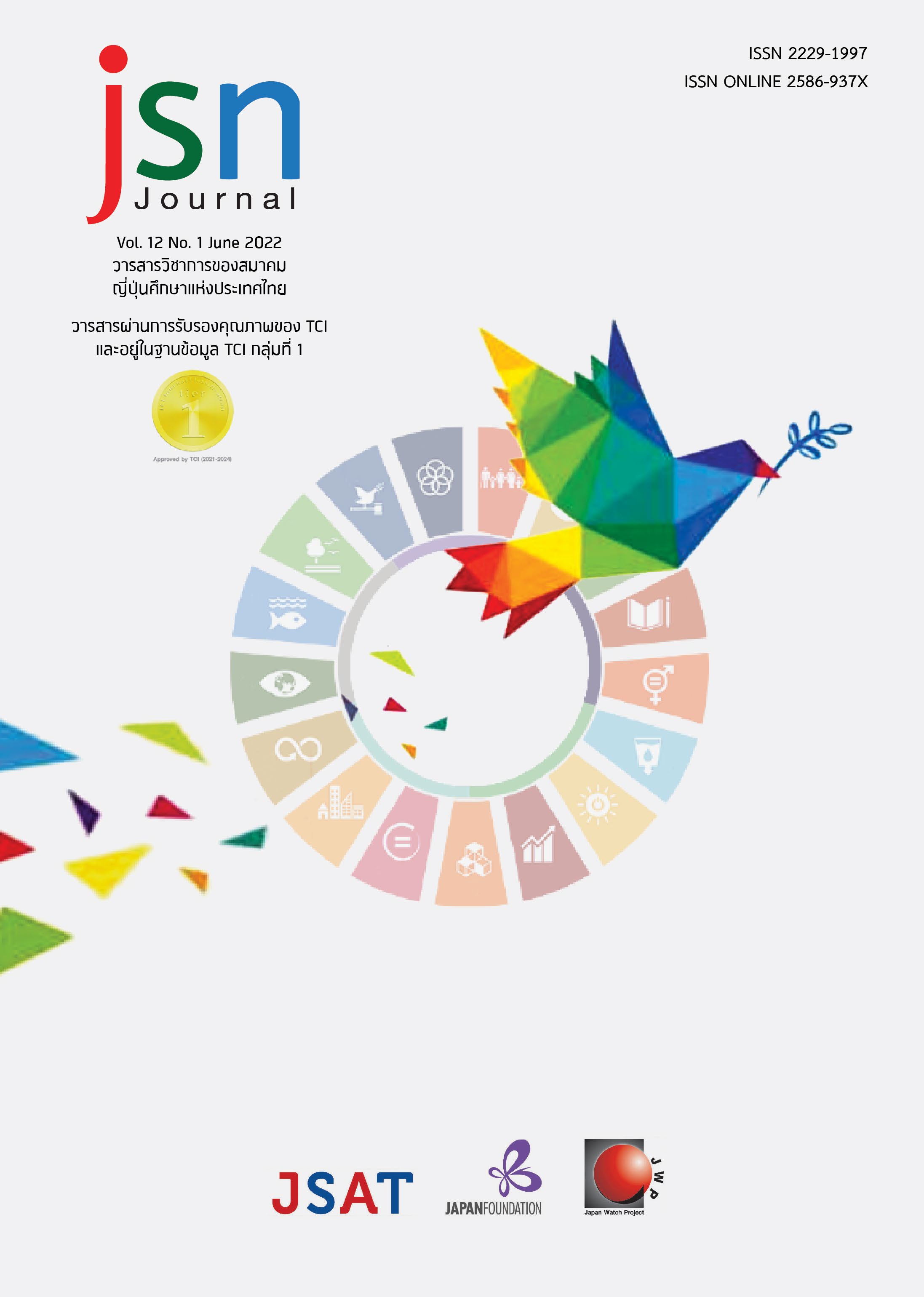Instructors’ Roles in Information Seeking Support in Classrooms A Case Study through the Survey of Smartphone Usage among Thai Learners of Japanese Language
Main Article Content
Abstract
This study aims to survey and analyze smartphone usage for information seeking in the classroom among Thai learners of Japanese language, focusing on the advantages and disadvantages of using smartphones to seek information. In addition, Thai learners of Japanese Language’s views on instructors’ roles in information seeking support in classrooms will also be analyzed. By simulating reading comprehension task and using questionnaires to collect data from Thai university students majoring in Japanese language, the results showed that most of the target group mostly sought information by using their smartphones to gain access to applications and websites (79.11%). Some advantages mentioned were associated with the smartphone’s ability to search promptly for word meanings, and its ability to search an enormous amount of data. On the other hand, there were also some disadvantages mentioned such as the lack of data, or data with insufficient explanations. Moreover, the study found that some of the target group mostly sought information from other students (17.91%) to inquire about the interpretations of sentences, which could not be achieved by using smartphone. The results indicated that instructors could play an important role not only in providing support for students both before and after the information seeking process, but also in utilizing the in-class learning environment by promoting knowledge sharing through interactions among students.
Article Details

This work is licensed under a Creative Commons Attribution-NonCommercial-NoDerivatives 4.0 International License.
ข้อความและข้อคิดเห็นต่างๆ ในบทความเป็นของผู้เขียนบทความนั้นๆ ไม่ใช่ความเห็นของกองบรรณาธิการหรือของวารสาร jsn Journal
References
ธัญธัช วิภัติภูมิประเทศ. (2559). พฤติกรรมการใช้สมาร์ทโฟนในชั้นเรียนของนักศึกษามหาวิทยาลัยธุรกิจบัณฑิตย์. วารสารสุทธิปริทัศน์, 30(95), 48-58.
เปี่ยมศักดิ์ เมนะเศวต, สันทัด ศิริอนันต์ไพบูลย์ และสมชัย บวรกิตติ. (2555). วิวัฒนาการโทรศัพท์มือถือในช่วง 20 ปี ที่ผ่านมา. วารสารราชบัณฑิตยสถาน, 37(4), 41-51.
สำนักงานสถิติแห่งชาติ. (2560). การสำรวจการมีการใช้เทคโนโลยีสารสนเทศและการสื่อสารในครัวเรือน พ.ศ. 2560. สืบค้นจาก http://www.nso.go.th/sites/2014/DocLib13/ด้านICT/เทคโนโลยีในครัวเรือน/2560/FullReportICT_60.pdf
สำนักงานสถิติแห่งชาติ. (2565). สำ รวจการมีการใช้เทคโนโลยีสารสนเทศและการสื่อสารในครัวเรือน พ.ศ. 2564 (ไตรมาส 4). สืบค้นจาก http://www.nso.go.th/sites/2014/DocLib13/ด้านICT/เทคโนโลยีในครัวเรือน/2564/fullreport_ict_q4_64.pdf
Braun, V., & Clarke, V. (2006). Using thematic analysis in psychology. Qualitative Researchin Psychology, 3(2), 77-101.
Morphitou, R. N., & Morphitis, A. (2014). The use of smartphones among students in relation to their education and social life. ICICTE 2014 Proceedings, 73-81.
Sontirak, T. (2018). Actual usage of smartphones for Japanese language study purposes in the classroom: Case of Thai learners of the Japanese language. Venezia ICJLE 2018 Book of Abstracts, 270-271.
Yu, F. (2012). Mobile/smart phone use in higher education. Retrieved from http://swdsi.org/swdsi2012/proceedings_2012/papers/Papers/PA144.pdf
青木直子 (2016).「21世紀の言語教育:拡大する地平、ぼやける境界、新たな可能性」 Journal CAJLE』17, 1-22.
伊藤秀明・石井容子・武田素子・山下悠貴乃 (2016).「日本語学習者のネット利用状況と学習サイトへの期待―海外拠点の調査結果から―」 国際交流基金日本語教育紀要』12, 97-104.
岩崎浩与司 (2020).「日本語教育におけるスマートフォンの活用―外国人留学生を対象としたメディアクラスの事例から―
e-Learning教育研究』14, 15-23.
葛茜 (2012). 日本語学習のためのインターネットの利用と問題点について―中国の大学日本語専攻生を対象に― 日本語学
刊』15, 182-195.
萱忠義 (2013).「言語学習におけるモバイル末端の新しい活用法」『学習院女子大学紀要』15, 19-29.
鄭起永 (2002).「日本語教育におけるマルチメディア活用の有効性と教師の役割」『明海日本語』7, 37-45.
陳那森・山下泰生・窪田八洲洋 (2016).「授業外修学におけるスマートデバイスの活用の可能性」 関西国際大学研
究紀要』17, 101-108.
林希和子・陳静怡・李雪・義永美央子 (2021).「JSL学習者の日本語実践におけるICTツールの使用状況―モバイル端末の利活用に関する質問紙調査報告―」 大阪大学国際教育交流センター研究論集 多文化社会と留学生交流』25, 75-83.
文化外国語専門学校編 (1997).『文化中級日本語 II』. 凡人社.
三國喜保子・谷口美穂・岩下智彦・山崎タルつぶら・張世襲・岩本尚希 (2011).「日本語学習者の教室外におけるメディア使用の実態―6カ国におけるアンケート調査から―」『桜美林言語教育論叢』7, 147-162


